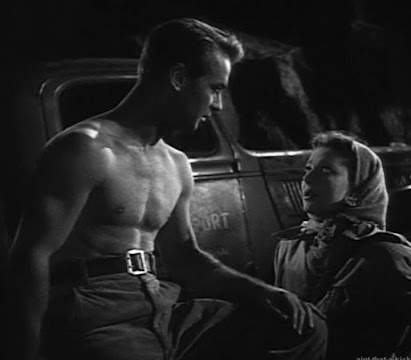Review: China (1943)
China is an outstanding 1943 adventure film from Paramount set against the backdrop of America's impending involvement in the second world war. Loretta Young (1946's The Stranger) takes the top billing as a compassionate schoolteacher working in China, determined to save as many lives as possible when Japan invades. Alan Ladd (come back, Shane) plays a tough guy profiteer who cares doesn't have time to get attached or involved. Frequent Ladd co-star William Bendix (The Glass Key, The Blue Dahlia) provides comic relief, but he's also part of the moral foundation of this film, pining for the safety of home, but recognizing the sacrifices necessary to do the right thing. Both Young and Bendix bring a spirit of dogged determination in the face of the powerful darkness that pervades this film.
None of this is a coincidence. Director John Farrow is one of many Hollywood professionals who laid down their cameras and took up military service when the fate of the world dangled in the balance. After making well over a dozen pictures at Warner Bros. and RKO, he enlisted into the Canadian Navy in 1939 and served as a lieutenant until he was released from service in 1942 after contracting typhus fever. When he returned to directing that year, he brought his real war experience to the screen in films like Wake Island, Commandos Strike at Dawn, China, and The Hitler Gang. For more about Hollywood during the war, check out the 2014 book Five Came Back by Mark Harris, as well as the subsequent 2017 documentary series. The facts are even more compelling than fiction.
Alan Ladd goes from an uninvested cynic who refuses to get involved to a rah-rah patriot over the course of 79 minutes, but it's hard to not be on board with such a drastic turnaround when this movie pulls so few punches. Nobody--literally no one--is safe from the brutality of war in this film, which has a body count in the dozens, often depicted as graphically as possible. Also worth mentioning, Ladd was only around 30 at the time of this film. He's young and lean and in his shirtless action scenes, almost looks carved out of stone. It's hard to believe that just two decades later, he'd be gone, a victim of his own vices. During this era, when Ladd was a stalwart of the studio system at its pinnacle, he was as much a movie star as Tom Cruise; a man of action with the dogged determination and all the sheer strength necessary to conquer any foe. Watching Ladd in his 1940s heyday is a reminder of what an amazing on-screen presence he still is.
China is a fantastic film. The cast works incredibly well together, anchored by Alan Ladd in full man-of-action mode. If you only know Ladd from his western work like Shane or the films he made after his lifestyle had taken a toll on his looks and physique, you owe it to yourself to watch this film to see how fit and capable he was at his peak. The action scenes alone are enough to sell this film, but there's a lot more to appreciate, from the special effects to the incredibly dark and violent tone of the film, which gets away with things the Code would never have allowed if so much of what happens in the film hadn't really been playing out in foreign battlefields. Don't miss this one.











I managed to see this film recently and really enjoyed it. "China" is a very dark movie and can be described as a Second World War Anti-Japanese/Propaganda film. On the surface, it appears to escape the normal prohibitions of the Hays Code, depicting much violence (mostly off screen). However, a price has to be paid and the character played by Alan Ladd must face up to his early actions. On the other hand, his two "white" well intentioned co-stars ( Loretta Young and William Bendix) are permitted to escape, but each at a personal cost.
ReplyDeleteI am surprised that "China" didn't (apparently) attract the later attention of "The House Of Un-American Activities", due to its favourable position on China. One interesting aside on this, is that the scriptwriter was Frank Butler ( a former silent movie actor), whose son Hugo Butler was also a screenwriter at the same time and was later "Blacklisted" by the HUAC for being a communist, although he continued working in Hollywood under several pseudonyms !